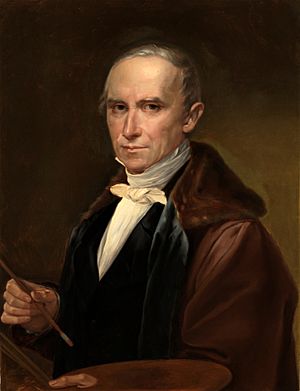José de Madrazo y Agudo facts for kids
Quick facts for kids
José de Madrazo y Agudo
|
|
|---|---|

José de Madrazo, Self-portrait, c.1840
|
|
| Born |
José de Madrazo y Agudo
22 April 1781 |
| Died | 8 May 1859 Madrid, Spain
|
| Nationality | Spanish |
| Education | Real Academia de Bellas Artes de San Fernando; Jacques-Louis David, Paris; Accademia di San Luca, Rome |
| Known for | Painter, etcher and lithographer; Director of the Prado Museum; Art collector |
| Movement | Neoclassical |
| Spouse(s) | Isabel Kuntze (daughter of artist, Tadeusz Kuntze) |
José de Madrazo y Agudo (born April 22, 1781 – died May 8, 1859) was a famous Spanish painter. He was also an engraver, which means he made prints from metal plates. José was one of the most important artists of the Neoclassical style in Spain. This style used ideas from ancient Greek and Roman art. He was the head of a very artistic family. His sons, Federico and Luis, and his grandsons, Raimundo and Ricardo, also became well-known painters.
Contents
José de Madrazo's Early Life
José was born in Santander. He started learning art at the Real Academia de Bellas Artes de San Fernando. His teacher there was Gregorio Ferro. Later, after 1803, José went to Paris to study with a very famous artist named Jacques-Louis David. David told him to apply for a special grant from the government. This grant would help him study art in Rome. José got the grant and moved to Rome.
Time in Rome
In 1806, José arrived in Rome. He continued his art training at the Accademia di San Luca. He also spent time studying ancient Roman and Greek art. While in Rome, he painted a picture about the death of Viriatus, a famous ancient leader. This painting was quite successful.
At this time, Spain had a new king, Joseph I. José refused to promise loyalty to this new king. Because of this, he and other Spanish artists in Rome were held in a place called the Castel Sant'Angelo. While he was there, he met the exiled King Carlos IV and his wife, María Luisa.
In 1809, José married Isabel Kuntze. Her father, Tadeusz Kuntze, was also a painter staying in Rome. In 1812, King Carlos IV came to Rome. He welcomed Madrazo into his group. The King even bought a painting called La muerte de Lucrecia, which he had not liked before. King Carlos also asked José to make copies of several old paintings. That same year, José painted a portrait of Manuel Godoy. The next year, he painted portraits of Godoy's wife and children.
José lost his position in 1815. This happened when the troops of Joachim Murat entered the Papal States. Murat wanted to unite Italy under French control. This made King Carlos leave his exile.
Return to Spain and Later Career
In 1818, José returned to Madrid. This was after the Bourbon Restoration, when the old royal family returned to power. Once back in Spain, he started working at the new Real Museo de Pinturas y Esculturas. Today, this museum is known as the Museo del Prado.
José helped organize and list all the artworks for King Fernando VII. He also created lithographs (a type of print) of the paintings for the museum's catalog. This was one of the first big uses of lithography in Spain.
In 1823, José was made Director of the San Fernando academy. Then, in 1838, he became Director of the Museo del Prado. He held this important job until 1857. He resigned after some criticism from the Royal family. José de Madrazo died in Madrid when he was 78 years old. He had collected many artworks himself. His collection was later sold and spread out.
José mostly painted religious and historical scenes. He worked with another artist, José Aparicio, to create art that showed Spanish patriotism. Some people later said his paintings felt a bit cold and too grand.
The Madrazo Family of Artists
The Madrazo family is known as one of the most important painting families in Spain during the 1800s. José's sons were:
- Federico de Madrazo: a painter
- Luis de Madrazo: a painter
- Pedro de Madrazo: an art critic
- Juan de Madrazo: an architect
His grandsons also became famous artists:
- Raimundo de Madrazo y Garreta: a painter
- Ricardo de Madrazo: a painter
José's granddaughter, Cecilia de Madrazo, married the well-known artist Mariano Fortuny.
Images for kids
See also
 In Spanish: José de Madrazo para niños
In Spanish: José de Madrazo para niños



